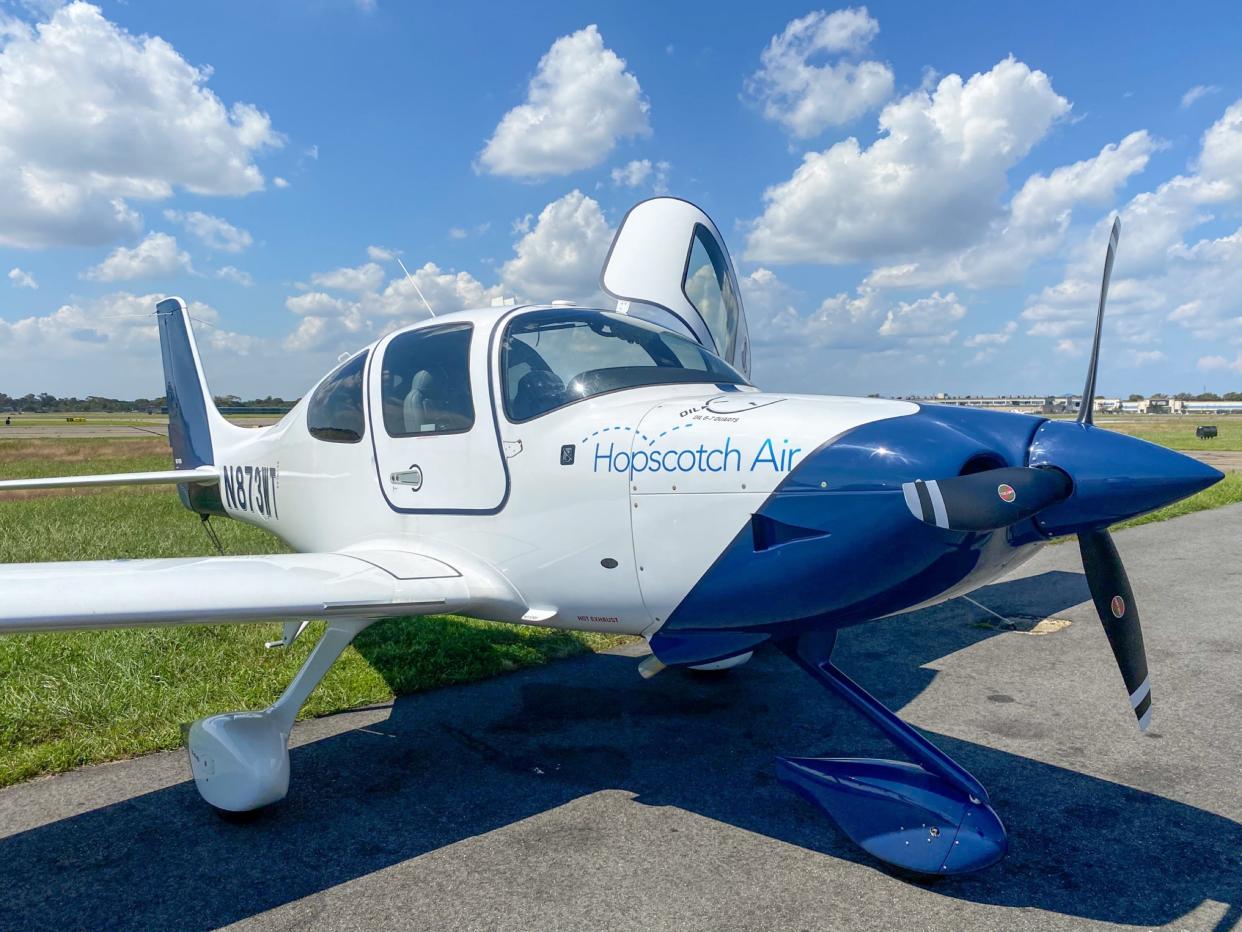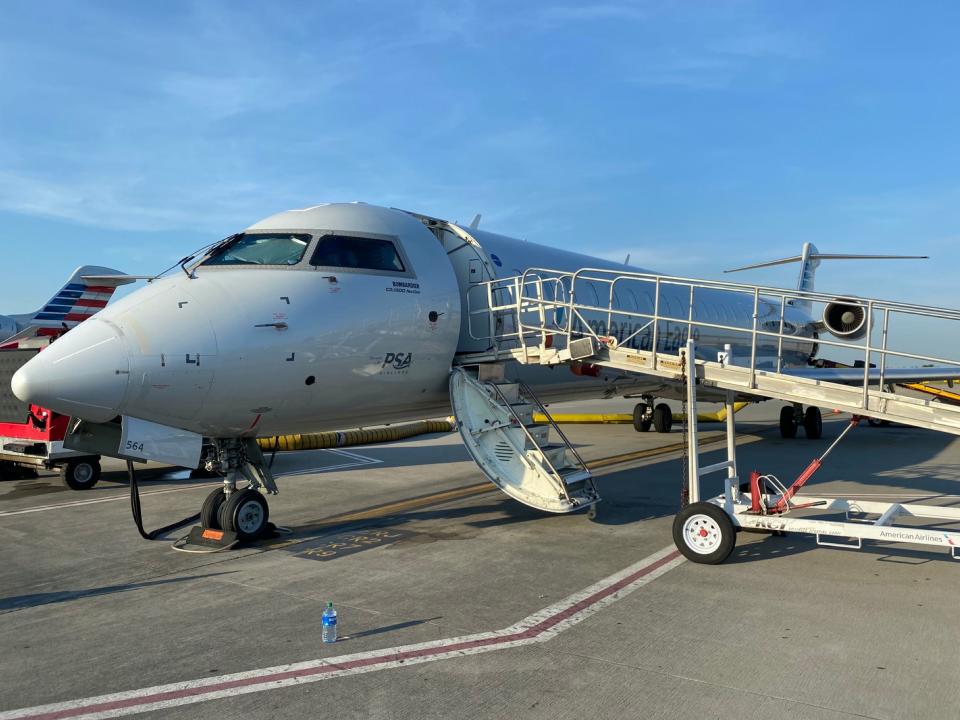The CEO of air taxi firm Hopscotch Air sees the pandemic as an opportunity to replace airlines as they abandon regional routes – here's how he plans to do it

Thomas Pallini/Business Insider
New York's Hopscotch Air is an air taxi firm that seeks to offer a cost-efficient alternative to aircraft charter with piston-powered aircraft.
CEO Andrew Schmertz has been using the downturn as a way to reimagine his operation and how air taxis can be used to fill the void left by regional airlines.
New travel trends show the wealthy flying more infrequently but also using the air taxis on longer routes as airlines become unreliable.
Hopscotch Air isn't your typical airline.
Andrew Schmertz started the air taxi firm in 2009 armed with a fleet of piston-powered Cirrus SR-20/22 series aircraft. The air taxi concept sought to make regional travel easier at a fraction of the cost for a private aircraft charter thanks to the cheaper economics of the aircraft compared to larger competitors.
Unlike the futuristic urban air mobility concepts where flying taxis depart from skyscraper rooftops, Hopscotch Air serves all of the New York metro region's executive airports including Republic Airport on Long Island, Westchester County Airport, and Teterboro Airport. Its aircraft fly the wealthy between the big city and leisure destinations across the Northeast and beyond.
The success of the operation prompted Schmertz to launch a membership division in 2019 where flyers pay $325 each month and receive special pricing and other perks. But the pandemic hasn't given Schmertz the uptick in business from which his larger competitors have been benefiting.
New pandemic travel trends are seeing the wealthy head to the second homes and stay put instead of commuting back and forth on the weekends, resulting in fewer flights for Hopscotch and prompting Schmertz to reimagine air taxi travel.
Here's how the pandemic is reshaping Hopscotch Air's air taxi operation.
Expanding the bounds of regional travel

Thomas Pallini/Business Insider
Private aviation has benefitted from the wealthy's desire to avoid the airlines and flyers are focused more on health and safety than any other topic when booking travel, according to Schmertz. Throughout the summer, the fear of commercial flight has given his aircraft the opportunity to fly longer and more lucrative routes.
The typical routes for Hopscotch Air during the summer are between New York and the Hamptons, Montauk, Cape Cod, and the Massachusetts islands while the winter might see flights between New York and Vermont. They're all short flights that are less than two hours in duration.
Customers more recently, however, have been pushing the limits of the aircraft by using them for longer flights. Schmertz reported that his pilots have flown customers as far as Chicago and North Carolina, destinations over three hours away when using the Cirrus aircraft compared to around two hours on an airliner.
The range of Hopscotch Air's current aircraft enable flights of up to around 800 miles, with cities like Chicago, Nashville, and Savannah at the top end of their non-stop range. Flights on a single-engine piston aircraft will take longer than an airliner but all the benefits of flying private such as using a private terminal and controlling the passenger manifest are available.
The Cirrus aircraft can also access smaller airports than some private jets. Commercial airlines serve around 500 airports in the US out of the nearly 5,000 public airports while the Cirrus planes, according to Schmertz, can access "nearly all of them."
Taking over for the regional airlines

Thomas Pallini/Business Insider
Airlines are showing symptoms of a reliability and connectivity problem as cancellations and schedule changes are becoming common when flying. With still less than 1 million daily travelers, some flights are departing with only a handful of passengers with airlines wanting to consolidate as much as possible to prevent money losers.
In a recent interview with Bloomberg, JetBlue Airways' CEO Robin Hayes said flights will be evaluated only three to four days in advance before the decision is made whether or not to cancel, as Business Insider found out on a recent flight to Chicago, leaving some passengers wary of booking airline tickets.
Route cuts are also becoming common with the major airlines leaving some US cities without air connectivity entirely. Delta Air Lines in June moved to end service to 11 cities across the country while American Airlines will stop flying to 15 cities, most of which are remote cities served by regional carriers.
Hopscotch Air wants to fill in the gaps left by the regionals in what Schmertz calls "right-sizing" the market. Instead of large regional jets, Schmertz will use smaller planes commensurate with the demand such as the Cirrus SR-20/22 series and the Quest Kodiak.
Airlines like Cape Air and Boutique Air currently fly to communities without much commercial traffic but the opportunity presented with the smaller aircraft used by Hopscotch can make the services more affordable while connecting the region.
The future of air taxi

Transcend Air
Limiting Hopscotch's growth is its aircraft's dependence on runways, which put the Cirrus aircraft at a disadvantage when competing against helicopters that can use any of the three heliports that Manhattan has to offer. That's why Schmertz is looking towards electric vertical take-off and land or eVTOL aircraft to power the air taxis of the future.
Working with Transcend Air – an eVTOL company looking to start flights between New York and Boston for less than $300 each way – Schmertz hopes that those aircraft can help get Hopscotch closer into the metropolitan areas where it can compete with the likes of Blade and other helicopter and seaplane operators.
For more traditional routes, Schmertz also hopes that the technology to power electric aircraft will enable further flights on larger aircraft, pointing to recent examples of battery-powered flight. Washington's MagniX in May flew a Cessna Caravan entirely on battery power, though a viable aircraft that can carry passengers long distances is still years away.
"We think that's where the business model is going all because we're not going to fix the two major problems – the pain points – which are the roads and the trains," Schmertz said, highlighting the US' lack of progress on fixing road and rail infrastructure.
Read the original article on Business Insider


